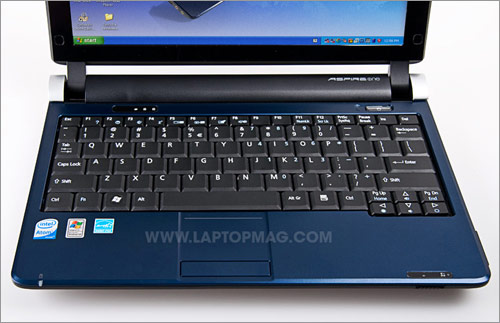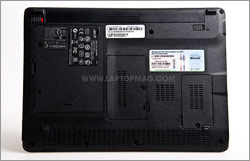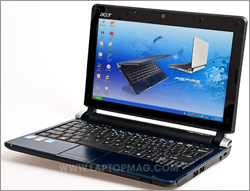Laptop Mag Verdict
Acer's flagship netbook gets smaller and lighter.
Pros
- +
Light, slim design
- +
Bright, crisp display
Cons
- -
Somewhat cramped keyboard
- -
Small touchpad
Why you can trust Laptop Mag
It's been only a few months since Acer debuted its Aspire One D150netbook, but already the company has come out with a slimmed-down model, the D250 (D250-1165), which is both thinner and lighter than its predecessor. However much lower the profile, though, Acer has still managed to cram in the same internal specs while keeping the price a reasonable $298 ($349 for the 6-cell model).
Design
In many ways, the Acer Aspire One D250 resembles the D150: It has the same keyboard, the same glossy black bezel surrounding a glossy 10.1-inch screen, and it's even a similar shade of blue on the lid and the keyboard deck. It doesn't have the metallic flecks of the D150, and the blue is more purple in tone, just enough for a noticeable difference. This netbook will also be available in black, white, and red.
At 10.2 x 7.2 x 1 inches and 2.2 pounds, it's 0.8 inches narrower, 0.3 inches thinner, and more than half a pound lighter than the D150. In fact, with its charger, the AOD250 weighs just 2.8 pounds, the same as the D150 alone. Remarkably, it's almost identical in thickness and weight to theASUS Eee PC 1008HA, but, because it doesn't have tapered sides, it looks larger at first glance.
Keyboard and Touchpad
The D250's keyboard, unchanged from the D150, is firm and easy to type on; we had no problems typing this review in Microsoft Word. But there's still a quarter inch of chassis on either side of the keyboard; a missed opportunity for Acer to install a larger, edge-to-edge keyboard, along the lines of the HP Mini 110 or Eee PC 1008HA.
The touchpad is comfortable to use, and offers very little friction, but at 2.0 x 1.5 inches, could be a little wider. The mouse button below is a single bar, lacking a divot to separate the two sides. Still, its action was crisp and not too stiff.

Click to enlarge
Display and Audio
As with the AOD150, the 10.1-inch LED-backlit screen on the D250 has a resolution of 1024 x 600. We're glad that Acer didn't skimp on the 24 vertical pixels in the name of boasting a 16:9 display. Even though it's a spacious 10 inches, at this size, every pixel counts. The glossy screen was crisp and displayed colors superbly; watching episodes of Saturday Night Live and The Simpsons on Hulu at full screen, we were impressed with how brightly it rendered colors. While horizontal viewing angles were excellent, tilting the screen forward almost immediately results in a distorted image.
The speakers on the D250 were about what we expect from a netbook; not all that powerful, and a little tinny--but they get the job done. Listening to Bruce Springsteen's "I'm on Fire" through Pandora, we felt the bass was on the thin side. The speakers would sound a lot better if they were placed on the keyboard deck, rather than on the underside of the front edge of the chassis; when we tilted the netbook backwards, songs not only sounded louder, but more detailed, too.
Ports and Webcam
Despite its slimmed-down physique, the D250 still manages to accommodate three USB ports, VGA, Ethernet, a 4-in-1 memory card slot, and headphone and mic ports. But the card slot is now on the right side (instead of the left), and the VGA, USB, and audio jacks have been moved further forward on the left side.

Click to enlarge

Click to enlarge
A 0.3-megapixel webcam above the display provided decent images when videoconferencing with a friend over Skype, but the image was a bit darker than that provided by theMSI Wind U120's 1.3-megapixel webcam. The microphone, located to the left of the webcam, allowed our caller to hear us loud and clear without our having to speak up.
Performance

Click to enlarge
Since its internal components are identical to the D150, we weren't surprised that the D250 garnered nearly the exact same scores in every department as its predecessor. Like every other netbook with a 1.6-GHz Intel Atom N270 processor, the D250 provided fairly decent performance. Its PCMark05 score of 1,492 is about 100 points higher than the netbook average, but not quite as robust as the ASUS Eee PC 1008HA (1,584), which has the slightly zippier 1.66-GHz Intel Atom N280 processor. Similarly, when we transcoded a 114MB video file from MPG4 to AVI using Handbrake, the D250 took 28:51 to complete the task, which is about 30 seconds faster than the netbook average and on a par with the HP Mini 110, but about 90 seconds slower than the Eee PC 1008HA.
The 160GB, 5,400-rpm hard drive booted Windows XP Home in a decent 49 seconds, almost the same time as the D150. On the LAPTOP Transfer Test (duplicating a 4.97GB folder of mixed media), however, the drive was marginally slower, taking 5 minutes 9 seconds to complete, at a rate of 16.5 MBps. That's about 2 MBps faster than the netbook average, but about 1 MBps slower than the AOD150.
The D250 was capable when it came to our graphics benchmarks, however. The Intel GMA 945 GPU notched a score of 741 in 3DMark03, more than 100 points above average, and its score of 123 in 3DMark06 was about 30 points above average. We had no problems streaming videos and playing movies off the hard drive. While it took a few seconds to render the Grand Canyon in Google Earth, we were able to fly around the southwest U.S. fairly smoothly. Still, zooming in and out of lower Manhattan with 3D buildings enabled proved choppy.
Wi-Fi and Battery Life

Click to enlarge
The D250's 802.11b/g Wi-Fi card performed well, achieving a throughput of 20.1 Mbps and 16.9 Mbps at 15 and 50 feet from our access point, respectively (whereas 18.9 Mbps and 15.7 Mbps are the netbook averages at those distances).
The 3-cell battery achieved a runtime of 3 hours and 4 minutes, which is about 15 minutes longer than the average 3-cell netbook battery. Acer will also offer a 6-cell battery which, if the battery on the D150's past performance is any indication, should provide about 6 hours of battery life. Unlike the 6-cell battery on the D150 (4400 mAh), the 6-cell battery being offered with the AOD250 will be a 5200-mAh, which should provide even more runtime. We will update this review once we've tested it.
Software
The Acer Aspire One D250 comes preloaded with a fair amount of software, including a 30-day trial of Microsoft Office 2007, Microsoft Works (which seems a bit redundant), Acer GameZone, Google Desktop, Carbonite Online Backup, and a 60-day trial of McAfee Security Center. It also comes with the Acer eRecovery Management application.
Configuration Options

Click to enlarge
Our configuration of the D250 (with a 3-cell battery) will set you back $298; the D250 with a 6-cell battery will cost $349 when it's released in June. Considering the extra runtime involved, we think it's worth spending the extra $50. Acer makes it easy for users to upgrade the hard drive and RAM on the D250, both of which are accessible via removable panels on the system's underside.
Verdict
Overall, we're very impressed with the Acer Aspire One D250. It performs very well, and at $298 ($349 with a 6-cell battery), it's competitively priced compared to both the ASUS Eee PC 1008HA ($429) and the MSI Wind U123 ($379), which, while $80 and $30 more expensive, respectively, have faster processors and long battery life (Check out Acer's performance in our Tech Support Showdown to see howthe manufacturer's supportstacks up against the competition). Still, we're at a loss as to why Acer felt it needed a nearly identical system in terms of price and performance, albeit one that's marginally thinner and lighter. We would much rather give up that extra 0.3 inches of thickness for a wider keyboard and touchpad. But, as far as netbooks go, the Acer Aspire One D250 is every bit as good as its predecessor, in an even smaller package.
Acer Aspire One AOD250 (AOD250-1165) Specs
| Brand | Acer |
| CPU | 1.6-GHz Intel Atom N270 |
| Card Slots | 4-1 card reader |
| Company Website | http://us.acer.com |
| Display Size | 10.1 |
| Graphics Card | Intel GMA 945 |
| Hard Drive Size | 160GB |
| Hard Drive Speed | 5,400rpm |
| Hard Drive Type | SATA Hard Drive |
| Native Resolution | 1024x600 |
| Operating System | MS Windows XP Home |
| Ports (excluding USB) | Microphone, Kensington Lock, Headphone, Ethernet, VGA |
| RAM | 1GB |
| RAM Upgradable to | 2GB |
| Size | 10.2 x 7.2 x 1.0 inches |
| USB Ports | 3 |
| Video Memory | 384MB |
| Warranty/Support | One year standard/24/7 toll-free phone |
| Weight | 2.8 pounds |
| Wi-Fi | 802.11b/g |
